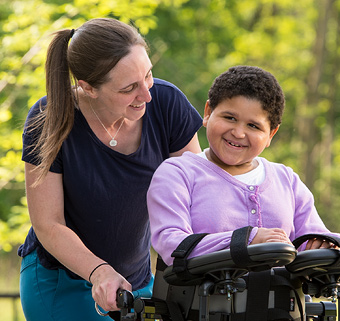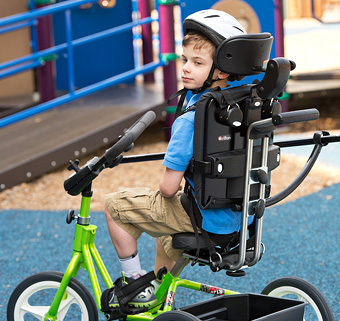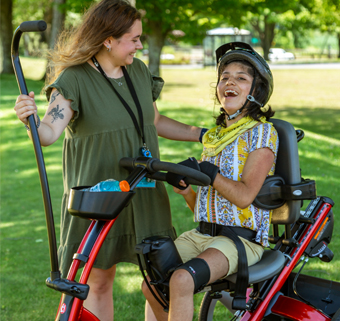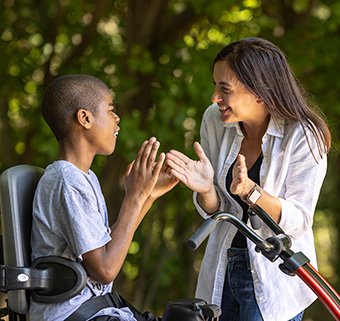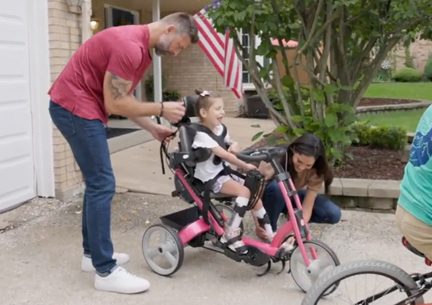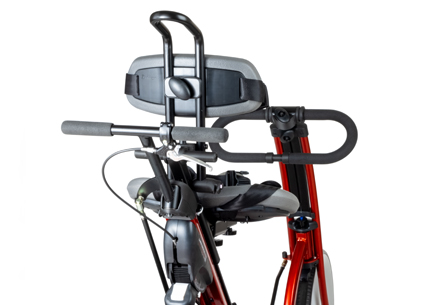Adaptive Tricycles in Schools
Opportunities for Participation, Motor Learning and Fitness
| September 2022 For a child with a disability such as cerebral palsy, the primary goal for the school-based therapist is to improve access to education. We’ve long known that encouraging independent mobility helps achieve this. Typically we do this by teaching the child to walk through gait training, or we give the child a wheelchair. The literature on gait training is convincing; no one disputes the overwhelming motor and social benefits of gait training.1 But what about those who are not yet ready for a gait trainer or who can only manage short sessions? Certainly, a wheelchair is one solution, but this passive seated mobility does not allow for acquiring motor skills and does not deliver the health benefits of physical activity.2
For a child with a disability such as cerebral palsy, the primary goal for the school-based therapist is to improve access to education. We’ve long known that encouraging independent mobility helps achieve this. Typically we do this by teaching the child to walk through gait training, or we give the child a wheelchair. The literature on gait training is convincing; no one disputes the overwhelming motor and social benefits of gait training.1 But what about those who are not yet ready for a gait trainer or who can only manage short sessions? Certainly, a wheelchair is one solution, but this passive seated mobility does not allow for acquiring motor skills and does not deliver the health benefits of physical activity.2
Enter the adaptive tricycle, used to provide children with the opportunity for independent mobility alongside gross motor improvements. In looking through the literature on adaptive cycling in pediatrics, the conclusion of one particular study jumped out: All children with cerebral palsy (CP) should be provided with an adaptive cycle in place of a wheelchair to enable active independent movement in community settings that will at the same time improve their endurance and function.3 Let’s address the use of adaptive tricycles as an alternative form of mobility and participation in the school-based setting.
The State of the Research
In one recently published systematic review, Efficacy of cycling interventions to improve function in children and adolescents with cerebral palsy: a systematic review and meta-analysis,4 the authors acknowledge the limitations of the research but underscore what we’ve long known instinctively: that adaptive cycling yields improvements in muscle strength, cardiovascular fitness, balance, and in standing and walking, as measured by domains D and E of the Gross Motor Function Measure (GMFM). Although this systematic review focuses on the benefits of adaptive cycles in all pediatric settings, a closer look at each contributing study adds valuable insights into how adaptive cycling should be used as an intervention in school and at home.
For instance, the earliest study in the systematic review establishes adaptive cycling as a safe and effective means of mobility for children with significant involvement. These children, all GMFCS levels IV and V, showed improvements in their cycling as well as carryover benefits in standing and walking after cycling sessions.5
Another case report from the review, Pilot evaluation of a school-based programme focused on activity, fitness, and function among children with cerebral palsy at GMFSC level IV, demonstrated improved fitness levels and reduced the health hazards associated with immobility from a structured 30-minute routine, including transfers on and off the bike.6
In a 2013 piece, the authors highlight the importance of fun, fitness, family and friendships in childhood. They explain how biking can encourage these “F-words in Childhood Disability”.7 A further randomized control trial, using quality of life and outcomes questionnaires, showed how children who cycled demonstrated improved emotional functioning through significant decreases in anxiety and anger, and were better able to pay attention in school.8 While this comes as no surprise, it is good to see such benefits documented in emerging literature.
Adaptive Cycling in Schools
Because a child spends most of the day in school, the interventions they receive should benefit them both academically and functionally. The Individuals with Disabilities Education Act,9 which defines standards of education for students with disabilities, acknowledges that educational benefits are not limited to academics. Rather it directs school-based practitioners to provide all students with an education designed to meet their unique needs, and prepare them for “further education, employment, and independent living.” (IDEA 2004)
Cycling is energy-efficient and cyclical, and thus is analogous to walking. It could be the bridge that provides an otherwise non-ambulatory child the opportunity to navigate the school environment, while at the same time building strength and stamina. The long term health benefits derived from biking will help these students improve mobility skills as they transition to future employment opportunities and independence in a long-term care setting.
According to motor learning theory, practice drives skill acquisition.10, 11 It takes practice to generate the rhythmic pattern necessary to pedal a tricycle. It takes practice to navigate and steer. It takes repetition and practice to build endurance. And to have lasting benefits, practice must be activity-based, goal-oriented, and contextual.2
Knowing that frequency of use and repetition leads to best outcomes encourages us to provide frequent opportunities to ride adaptive bikes throughout a child’s day. The structure of a school day offers many countless opportunities for children to use adaptive bikes as an alternative to wheelchairs. Moving to the playground for recess, from the bus to the classroom, or during adaptive physical education are examples.
Adaptive Cycling Take-Away
The 2015 Mohanty study is sparking discussion on using adaptive bikes in place of wheelchairs for community mobility. Their research shows that children with spastic diplegic cerebral palsy who biked at an outdoor campus for an hour demonstrated gains in functional mobility, balance, and cardiovascular fitness compared to their non-cycling (conventional therapy only) counterparts.
Offering alternative forms of mobility in the school environment could increase gains for students who otherwise spend much of the day in wheelchairs. Effectively implementing research into practice is part of the school-based practitioner’s job. The research we have to date highlights how we can make better use of mobility options throughout a child’s day for improving their physical health and well-being.
References
- Jackman M, Sakzewski L, Morgan C, Boyd RN, Brennan SE, Langdon K, et al. Interventions to improve physical function for children and young people with cerebral palsy: international clinical practice guideline. Dev Med Child Neurol. 2021. DOI: 10.1111/dmcn.15055.
- Novak I, Morgan C, Fahey M. State of the Evidence Traffic Lights 2019: Systematic Review of Interventions for Preventing and Treating Children with Cerebral Palsy. Current Neurology & Neuroscience Reports. 2020;20(2):1–21.
- Mohanty P, Meshram N, Pattnaik M. Comparison of dynamic cycling vs static cycling on endurance, balance, and walking ability of children with cerebral palsy. Int J Physiother Res 2015;3(4):1163-1170.
- Armstrong EL, Spencer S, Kentish MJ, Horan SA, Carty CP, Boyd RN. Efficacy of cycling interventions to improve function in children and adolescents with cerebral palsy: a systematic review and meta-analysis. Clin Rehabil. 2019 Jul;33(7):1113-1129.
- Williams H, Pountney T. Effects of a static bicycling programme on the functional ability of young people with cerebral palsy who are non-ambulant. Dev Med Child Neurol. 2007 Jul;49(7):522-7.
- Daly C, Moore CL, Johannes S, et al. Pilot evaluation of a school-based programme focused on activity, fitness, and function among children with cerebral palsy at GMFSC level IV: single-subject research. Physiotherapy Canada. 2020;72(2):195-204.
- Pickering D, Horrocks LM, Visser KS, Todd G. 'Every picture tells a story': Interviews and diaries with children with cerebral palsy about adapted cycling. J Paediatr Child Health. 2013;49(12):1040-4.
- Demuth SK, Knutson LM, Fowler EG. The PEDALS stationary cycling intervention and health-related quality of life in children with cerebral palsy: a randomized controlled trial. Dev Med Child Neurol. 2012; 54(7):654-61.
- IDEA Individuals with Disabilities Education Act: Statute and Regulations https://sites.ed.gov/idea/statuteregulations/. Accessed June 2022.
- Carr and Shepherd. A Motor Learning Model for Rehabilitation. Movement Science. 1987; Aspen Publishers.
- Carr and Shepherd. Neurological Rehabilitation: Optimizing Motor Performance. 2011; Churchhill Livingstone.
